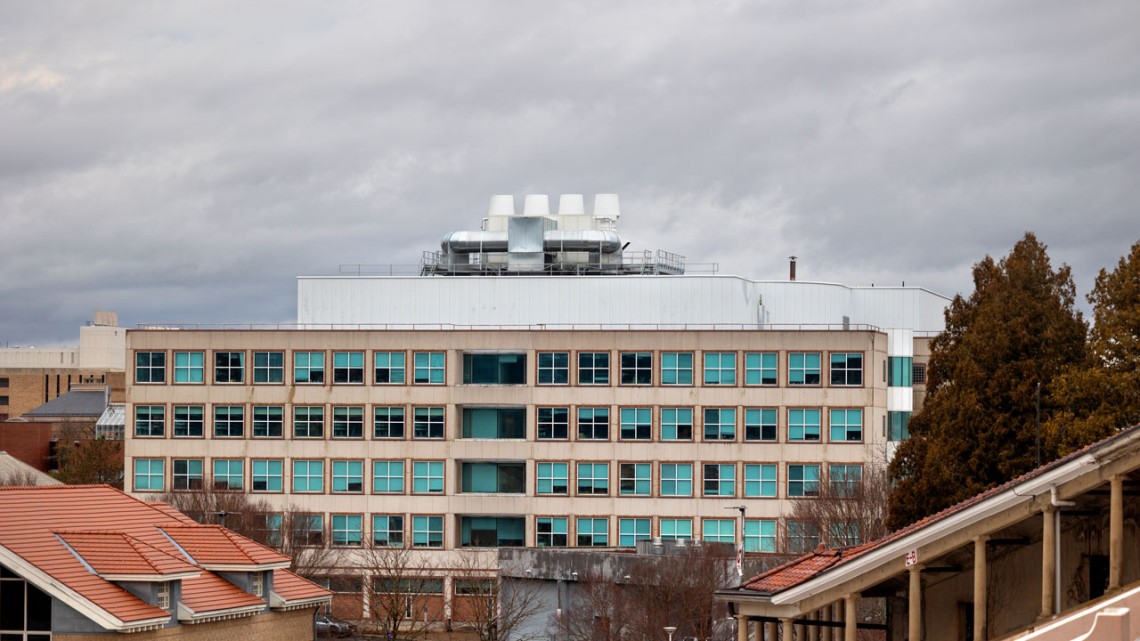
The Biotechnology Building has been retrofitted since 2004 to recover heat, save energy and reduce carbon dioxide emissions
Biotechnology Building retrofit saves $670K in annual energy
By Blaine Friedlander, Cornell Chronicle
Campus engineers have verified that the Biotechnology Building – which has undergone several distinct phases of efficiency tailoring since 2004, including a recently completed retrofit of four rooftop exhaust stacks to recover heat – now saves nearly $670,000 in annual energy costs compared to 2004.
The $2.76 million retrofit effort, which sought to recover heat, save energy and reduce carbon dioxide emissions, began in mid-2022 and was completed in January.
“Biotech is a beautiful story of the Cornell Energy Conservation Initiative effort in an old, complicated and mission-critical lab facility,” said Cole Tucker, director of utilities distribution and energy management, part of the Facilities and Campus Services division. “We’ve now finished installing a massive heat-recovery system – the final piece in our two decades of effort for the Biotechnology Building.”
Cornell’s Energy and Sustainability group partnered with Facilities Maintenance Management to replace aging equipment and retrofit a glycol heat recovery system to the rooftop exhaust stacks. It was a robust way to reduce the heating and cooling demands of this ventilation-intensive building, said Sam Fairchild, energy engineer, in Facilities and Campus Services.
Before the heat-recovery system, ventilation air was taken directly from outdoors, then heated or cooled before being supplied to Biotechnology Building’s labs and offices.
This conditioned air was then expelled through the lab exhaust stacks on the roof, wasting energy and money, Fairchild said. Now, the heat or chill of the conditioned air is recovered and can significantly reduce the energy needed to control temperatures in the building.
Twenty years ago, Cornell was spending $1.4 million annually to supply the building’s electric, heat and cooling needs, Fairchild said. Through the Energy Conservation Initiative – a pillar of the university’s 2035 Carbon Neutrality goal – energy costs at the Biotechnology Building were reduced to $939,000, saving about $493,000 annually to date.
The Biotechnology Building hosts 80 labs with 84 energy-consuming fume hoods. Each of these hoods, which safely exhaust chemicals and fumes during the research process, has the potential to consume the annual energy output equivalent of about 3.5 homes. Combined, the hoods in the facility use enough energy each year to power more than 294 homes.
When the building first opened in 1989, the air within the Biotechnology Building labs was mechanically changed 20 times each hour, an energy-intensive process. Energy and Sustainability replaced the pneumatic control system in 2004 for a more precise digital-control system, according to the facilities group. Those 20 air changes per hour were reduced to eight, with the guidance of Cornell’s Environmental Health and Safety group.
By 2011, the eight air changes per hour were reduced to six, as the labs were retrofitted with occupancy sensors and additional controls. This reduced ventilation rates to about three hourly air changes during unoccupied lab periods.
Offices in the building experienced a similar digital and mechanical upgrade in 2019.
“Biotech’s energy history demonstrates that persistence and partnership pay off,” Tucker said.
Tucker said that the two decades of work on the building cost about $5.2 million in total, with $670,000 in annual energy savings, resulting in a 7.7-year simple payback.
“When you factor in capital expense reductions for utility production equipment associated with peak load reduction, addressed deferred maintenance on critical exhaust systems and tapping state energy grants, the economics of this effort only get better,” Tucker said.
“All of this adds up,” Tucker said. “We have reduced the Biotechnology Building’s annual energy consumption by 46% from the 2004 baseline. This new recovery system translates directly into a reduced capital expense for renewing and expanding our capacity for growing campus. That’s compelling.”
Media Contact
Get Cornell news delivered right to your inbox.
Subscribe
